In-Field Tobacco Leaf Maturity Detection with an Enhanced MobileNetV1: Incorporating a Feature Pyramid Network and Attention Mechanism
Abstract
1. Introduction
2. Material and Methods
2.1. In-Situ Tobacco Leaf Sample Collection in the Field
2.2. Training, Validation, and Test Set Division
2.3. Data Preprocessing and Augmentation
2.4. Tobacco Leaf Maturity Recognition Model Based on Improved MobileNetV1
2.4.1. Structure of the MobileNetV1 Model
2.4.2. Incorporating FPN for Feature Pyramid Construction
2.4.3. Integration of Spatial Attention Mechanism and SE Attention Mechanism
2.4.4. Overview of the Enhanced MobileNetV1 Model
2.5. Model Training and Validation
2.5.1. Training Parameters and Optimization Strategy
2.5.2. Training Parameters and Optimization Strategy
3. Results and Discussion
3.1. Experiment Environment and Parameters
3.2. Optimizer and Learning Rate Selection
3.3. Ablation Study
3.4. Performance Evaluation of Different Models
3.5. Model Robustness Evaluation against Real-World Application Challenges
3.6. Analysis and Visualization of Maturity Recognition Results
3.7. Validation of the Enhanced MobileNetV1 on the V2 Plant Seedlings Dataset
4. Discussion
5. Conclusions
Author Contributions
Funding
Institutional Review Board Statement
Informed Consent Statement
Data Availability Statement
Conflicts of Interest
Abbreviations
| CNN | Convolutional Neural Network |
| FPN | Feature Pyramid Network |
| SE | Squeeze and Excitation |
| SP | Spatial Attention |
References
- Wang, B.Y.; Du, Y.D.; Teng, G.B. Tobacco raw material production should meet the requirements of cigarette industry. Chin. Tob. Sci. 2002, 1, 30–32. [Google Scholar]
- Kays, S.J. Cultivated Vegetables of the World: A Multilingual Onomasticon; Wageningen Academic Publishers: Wageningen, The Netherlands, 2011. [Google Scholar] [CrossRef]
- Yin, F.; Karangwa, E.; Song, S.; Duhoranimana, E.; Lin, S.; Cui, H.; Zhang, X. Contribution of tobacco composition compounds to characteristic aroma of Chinese faint-scent cigarettes through chromatography analysis and partial least squares regression. J. Chromatogr. B 2019, 1105, 217–227. [Google Scholar] [CrossRef] [PubMed]
- Gao, F.L.; Liu, X.W.; Du, Z.G.; Hou, H.; Wang, X.Y.; Wang, F.L.; Yang, J.G. Bayesian phylodynamic analysis reveals the dispersal patterns of tobacco mosaic virus in China. Virology 2019, 528, 110–117. [Google Scholar] [CrossRef]
- Zou, C.M.; Li, Y.; Huang, W.; Zhao, G.K.; Pu, G.R.; Su, J.E.; Coyne, M.S.; Chen, Y.; Wang, L.C.; Hu, X.D. Rotation and manure amendment increase soil macro-aggregates and associated carbon and nitrogen stocks in flue-cured tobacco production. Geoderma 2018, 325, 49–58. [Google Scholar] [CrossRef]
- Chen, Y.J.; Ren, K.; Su, J.E.; He, X.; Zhao, G.K.; Hu, B.B.; Chen, Y.; Xu, Z.L.; Jin, Y.; Zou, C.M. Rotation and organic fertilizers stabilize soil water-stable aggregates and their associated carbon and nitrogen in flue-cured tobacco production. J. Soil Sci. Plant Nutr. 2020, 20, 192–205. [Google Scholar] [CrossRef]
- Xiao, B.G.; Zhu, J.; Lu, X.P.; Bai, Y.F.; Li, Y.P. Analysis on genetic contribution of agronomic traits to total sugar in flue-cured tobacco (Nicotiana tabacum L.). Field Crops Res. 2007, 102, 98–103. [Google Scholar] [CrossRef]
- Zhang, F.; Zhang, X. Classification and quality evaluation of tobacco leaves based on image processing and fuzzy comprehensive evaluation. Sensors 2011, 11, 2369–2384. [Google Scholar] [CrossRef]
- Yu, T.; Zhang, X.; Gao, S.; Cao, M.; Lei, X.; Yang, Y.; Liu, Y.; Zhu, L.; Tian, B.; Gu, H.; et al. Tobacco growth monitoring and variety identification based on electrochemical fingerprints. Int. J. Electrochem. Sci. 2022, 17, 2. [Google Scholar] [CrossRef]
- Chen, Y.; Bin, J.; Zou, C.; Ding, M. Discrimination of fresh tobacco leaves with different maturity levels by near-infrared (NIR) spectroscopy and deep learning. J. Anal. Methods Chem. 2021, 2021, 9912589. [Google Scholar] [CrossRef]
- Lu, X.; Zhao, C.; Qin, Y.; Xie, L.; Wang, T.; Wu, Z.; Xu, Z. The Application of Hyperspectral Images in the Classification of Fresh Leaves’ Maturity for Flue-Curing Tobacco. Processes 2023, 11, 1249. [Google Scholar] [CrossRef]
- Kamilaris, A.; Prenafeta-Boldú, F.X. Deep learning in agriculture: A survey. Comput. Electron. Agric. 2018, 147, 70–90. [Google Scholar] [CrossRef]
- Rahnemoonfar, M.; Sheppard, C. Deep count: Fruit counting based on deep simulated learning. Sensors 2017, 17, 905. [Google Scholar] [CrossRef]
- Mallikarjuna, P.B.; Guru, D.S. Selective Harvesting of Tobacco Leaves: An Approach Based on Texture Features. Stat. Appl. 2022, 20, 33–49. [Google Scholar]
- Guru, D.S.; Mallikarjuna, P.B. Spots and color-based ripeness evaluation of tobacco leaves for automatic harvesting. In Proceedings of the First International Conference on Intelligent Interactive Technologies and Multimedia, Allahabad, India, 27–30 December 2010; pp. 198–202. [Google Scholar] [CrossRef]
- Mallikarjuna, P.B.; Guru, D.S.; Shadaksharaiah, C. Ripeness Evaluation of Tobacco Leaves for Automatic Harvesting: An Approach Based on Combination of Filters and Color Models. In Data Science: Theory, Algorithms, and Applications; Springer: Singapore, 2021; pp. 197–213. [Google Scholar] [CrossRef]
- Xu, R.; Li, C.; Paterson, A.H.; Jiang, Y.; Sun, S.; Robertson, J.S. Aerial images and convolutional neural network for cotton bloom detection. Front. Plant Sci. 2018, 8, 2235. [Google Scholar] [CrossRef]
- Begue, A.; Kowlessur, V.; Singh, U.; Mahomoodally, F.; Pudaruth, S. Automatic recognition of medicinal plants using machine learning techniques. Int. J. Adv. Comput. Sci. Appl. 2017, 8, 166–175. [Google Scholar] [CrossRef]
- Lu, H.; Cao, Z.; Xiao, Y.; Zhuang, B.; Shen, C. TasselNet: Counting maize tassels in the wild via local counts regression network. Plant Methods 2017, 13, 1–17. [Google Scholar] [CrossRef]
- Ghosal, S.; Blystone, D.; Singh, A.K.; Ganapathysubramanian, B.; Singh, A.; Sarkar, S. An explainable deep machine vision framework for plant stress phenotyping. Proc. Natl. Acad. Sci. USA 2018, 115, 4613–4618. [Google Scholar] [CrossRef]
- Polder, G.; van der Heijden, G.W.A.M.; Young, I.T. Spectral image analysis for measuring ripeness of tomatoes. Trans. ASAE 2002, 45, 1155. [Google Scholar] [CrossRef]
- Krizhevsky, A.; Sutskever, I.; Hinton, G.E. Imagenet classification with deep convolutional neural networks. Commun. ACM 2017, 60, 84–90. [Google Scholar] [CrossRef]
- Girshick, R.; Donahue, J.; Darrell, T.; Malik, J. Rich feature hierarchies for accurate object detection and semantic segmentation. In Proceedings of the IEEE Conference on Computer Vision and Pattern Recognition, Columbus, OH, USA, 23–28 June 2014. [Google Scholar] [CrossRef]
- He, K.; Zhang, X.; Ren, S.; Sun, J. Deep residual learning for image recognition. In Proceedings of the IEEE Conference on Computer Vision and Pattern Recognition, Las Vegas, NV, USA, 27–30 June 2016. [Google Scholar] [CrossRef]
- Chen, Y.; Bin, J.; Jiang, Y. Application of Machine Vision and Convolutional Neural Networks in Distinguishing of Tobacco Leaf Maturity by Mobile Devices. Appl. Sci. 2022, 33, 6999–7019. [Google Scholar]
- Li, J.X.; Zhao, H.; Zhu, S.P.; Huang, H.; Miao, Y.J.; Jiang, Z.Y. An improved lightweight network architecture for identifying tobacco leaf maturity based on Deep learning. J. Intell. Fuzzy Syst. 2021, 41, 4149–4158. [Google Scholar] [CrossRef]
- Aquino, A.; Barrio, I.; Diago, M.P.; Millan, B.; Tardaguila, J. VitisBerry: An Android smartphone application to early evaluate the number of grape vine berries by means of image analysis. Comput. Electron. Agric. 2018, 148, 19–28. [Google Scholar] [CrossRef]
- Wang, Q.; Xi, L.; Ren, Y.N.; Ma, X.X. Determination of Tobacco Leaf Maturity Degree Based on Computer Vision Technology. Trans. Chin. Soc. Agric. Eng. 2012, 28, 175–179. [Google Scholar]
- Wang, X.; Zhang, M.J.; He, Z.F. Effects of Harvest Maturity on Quality of Cured Tobacco Leaves. Chin. Agric. Sci. Bull. 2017, 33, 161–164. [Google Scholar]
- Howard, A.G.; Zhu, M.; Chen, B.; Kalenichenko, D.; Wang, W.; Weyand, T.; Andreetto, M.; Adam, H. Mobilenets: Efficient convolutional neural networks for mobile vision applications. Unpublished work. arXiv 2017, arXiv:1704.04861. [Google Scholar]
- Sandler, M.; Howard, A.; Zhu, M.; Zhmoginov, A.; Chen, L. Mobilenetv2: Inverted residuals and linear bottlenecks. In Proceedings of the IEEE Conference on Computer Vision and Pattern Recognition, Salt Lake City, UT, USA, 18–23 June 2018. [Google Scholar] [CrossRef]
- Lin, T.Y.; Dollár, P.; Girshick, R.; He, K.; Hariharan, B.; Belongie, S. Feature Pyramid Networks for Object Detection. In Proceedings of the IEEE Conference on Computer Vision and Pattern Recognition, Honolulu, HI, USA, 21–26 July 2017. [Google Scholar] [CrossRef]
- Woo, S.; Park, J.; Lee, J.Y.; Kweon, I.S. Cbam: Convolutional block attention module. In Proceedings of the European Conference on Computer Vision (ECCV), Munich, Germany, 8–14 September 2018; pp. 3–19. [Google Scholar] [CrossRef]
- Hu, J.; Shen, L.; Sun, G. Squeeze-and-excitation networks. In Proceedings of the IEEE Conference on Computer Vision and Pattern Recognition, Salt Lake City, UT, USA, 18–23 June 2018; pp. 7132–7141. [Google Scholar] [CrossRef]
- Wang, H.; Du, M.; Yang, F.; Zhang, Z. Score-CAM: Score-Weighted Visual Explanations for Convolutional Neural Networks. In Proceedings of the 2020 IEEE/CVF Conference on Computer Vision and Pattern Recognition Workshops (CVPRW), Seattle, WA, USA, 13–19 June 2020; pp. 111–119. [Google Scholar] [CrossRef]
- Mu, Y.; Feng, R.; Ni, R.; Li, J.; Luo, T.; Liu, T.; Li, X.; Gong, H.; Guo, Y.; Sun, Y.; et al. A Faster R-CNN-Based Model for the Identification of Weed Seedling. Agronomy 2022, 12, 2867. [Google Scholar] [CrossRef]
- Rahman, N.R.; Hasan, A.M.; Shin, J. Performance comparison of different convolutional neural network architectures for plant seedling classification. In Proceedings of the 2020 2nd International Conference on Advanced Information and Communication Technology (ICAICT), Dhaka, Bangladesh, 28–29 November 2020; pp. 146–150. [Google Scholar]
- Makanapura, N.; Sujatha, C.; Patil, P.R.; Desai, P. Classification of plant seedlings using deep convolutional neural network architectures. J. Phys. Conf. Ser. 2022, 2161, 012006. [Google Scholar] [CrossRef]
- Chen, Y.; Dai, X.; Chen, D.; Liu, M.; Dong, X.; Yuan, L.; Liu, Z. Mobile-former: Bridging mobilenet and transformer. In Proceedings of the IEEE/CVF Conference on Computer Vision and Pattern Recognition, New Orleans, LA, USA, 19–20 June 2022; pp. 5270–5279. [Google Scholar]
- Cui, Y.; Jiang, C.; Wang, L.; Wu, G. Mixformer: End-to-end tracking with iterative mixed attention. In Proceedings of the IEEE/CVF Conference on Computer Vision and Pattern Recognition, New Orleans, LA, USA, 18–24 June 2022; pp. 13608–13618. [Google Scholar]
- Zhang, W.; Huang, Z.; Luo, G.; Chen, T.; Wang, X.; Liu, W.; Shen, C. TopFormer: Token pyramid transformer for mobile semantic segmentation. In Proceedings of the IEEE/CVF Conference on Computer Vision and Pattern Recognition, New Orleans, LA, USA, 18–24 June 2022; pp. 12083–12093. [Google Scholar]
- Li, Y.; Yuan, G.; Wen, Y.; Hu, J.; Evangelidis, G.; Tulyakov, S.; Ren, J. Efficientformer: Vision transformers at mobilenet speed. Adv. Neural Inf. Process. Syst. 2022, 35, 12934–12949. [Google Scholar]
- Ding, X.; Zhang, X.; Ma, N.; Han, J.; Ding, G.; Sun, J. Repvgg: Making vgg-style convnets great again. In Proceedings of the IEEE/CVF Conference on Computer Vision and Pattern Recognition, Nashville, TN, USA, 20–25 June 2021; pp. 13733–13742. [Google Scholar]
- Graham, B.; El-Nouby, A.; Touvron, H.; Stock, P.; Joulin, A.; Jégou, H.; Douze, M. Levit: A vision transformer in convnet’s clothing for faster inference. In Proceedings of the IEEE/CVF International Conference on Computer Vision, Montreal, QC, Canada, 10–17 October 2021; pp. 12259–12269. [Google Scholar]

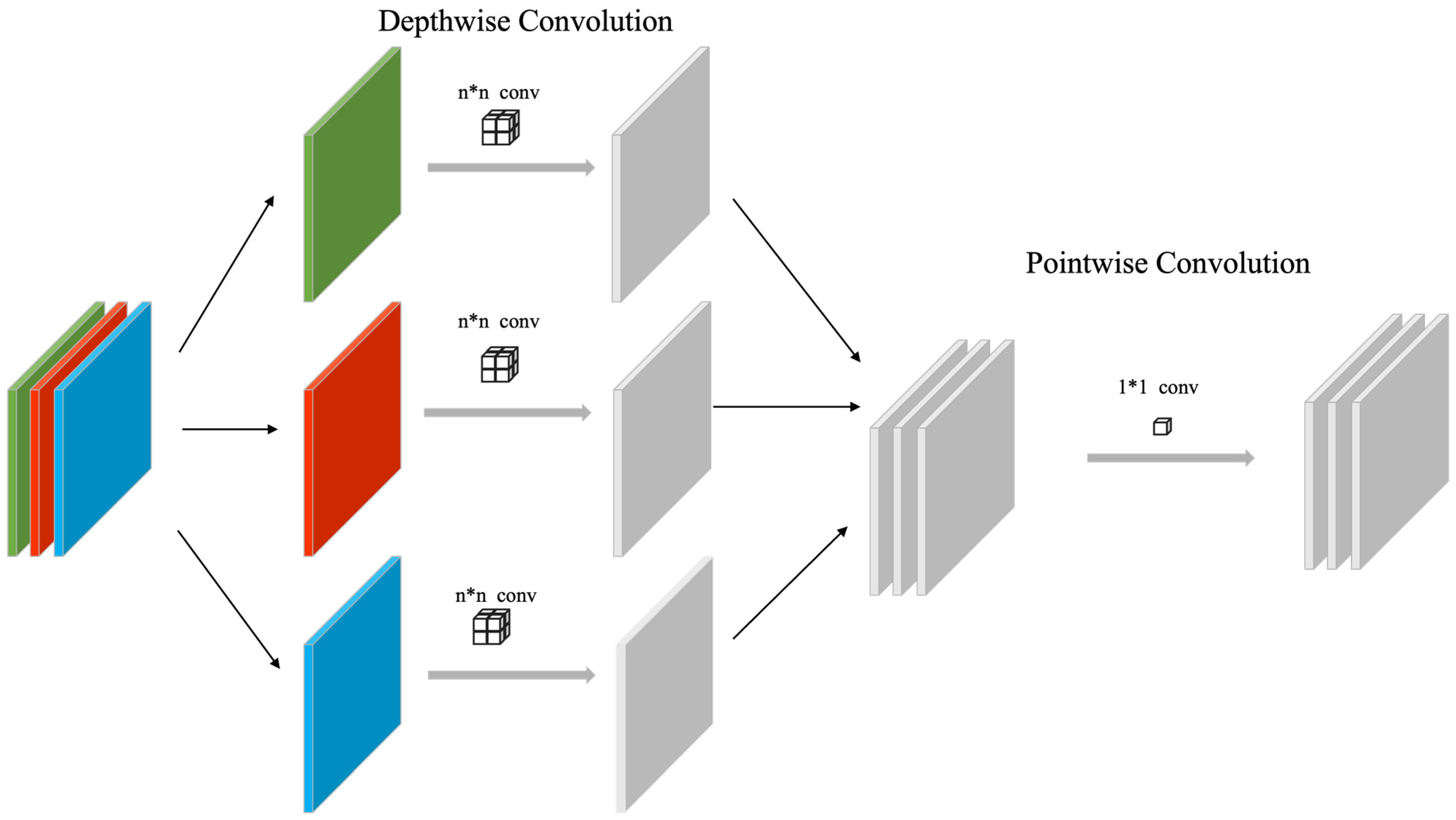
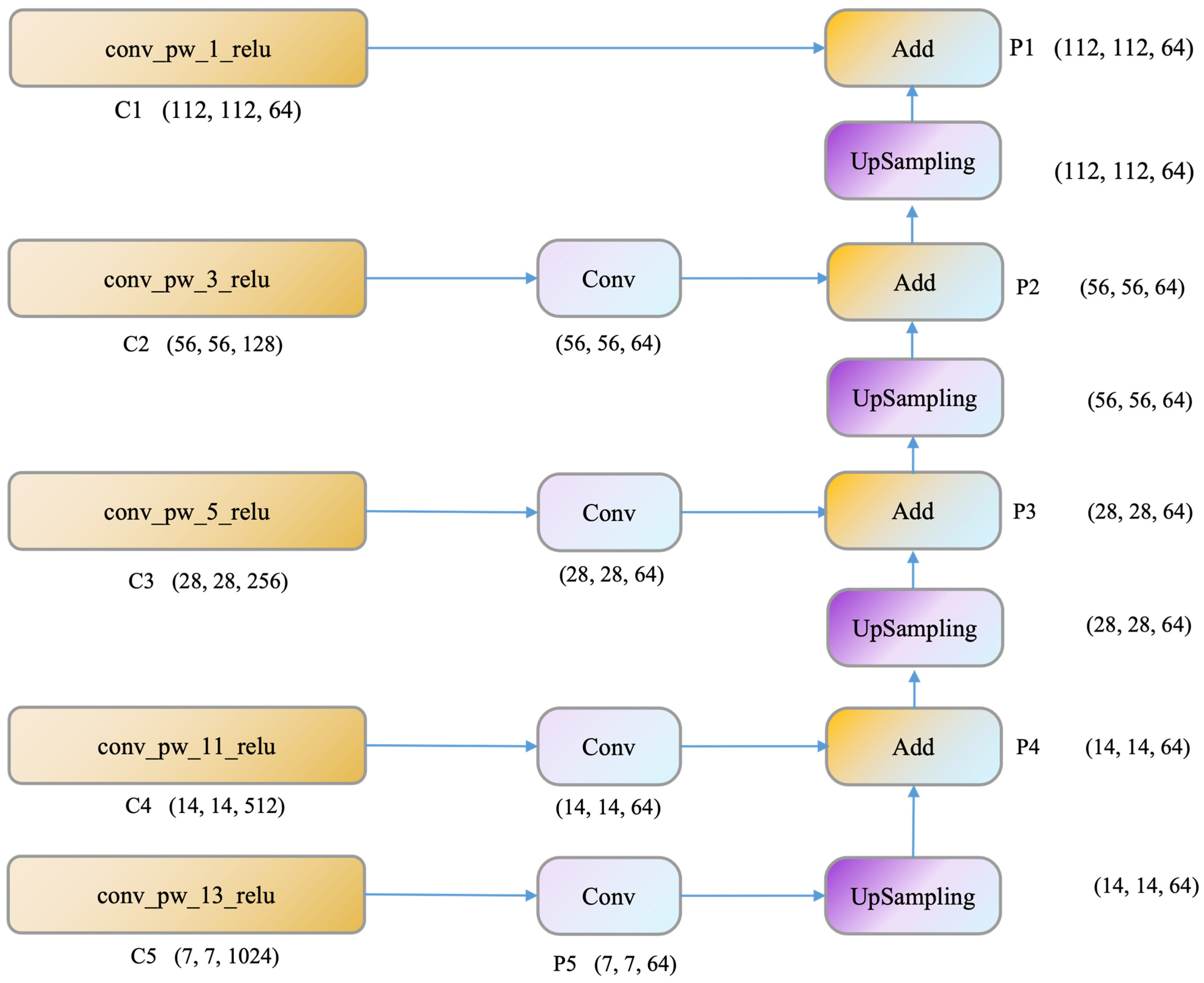
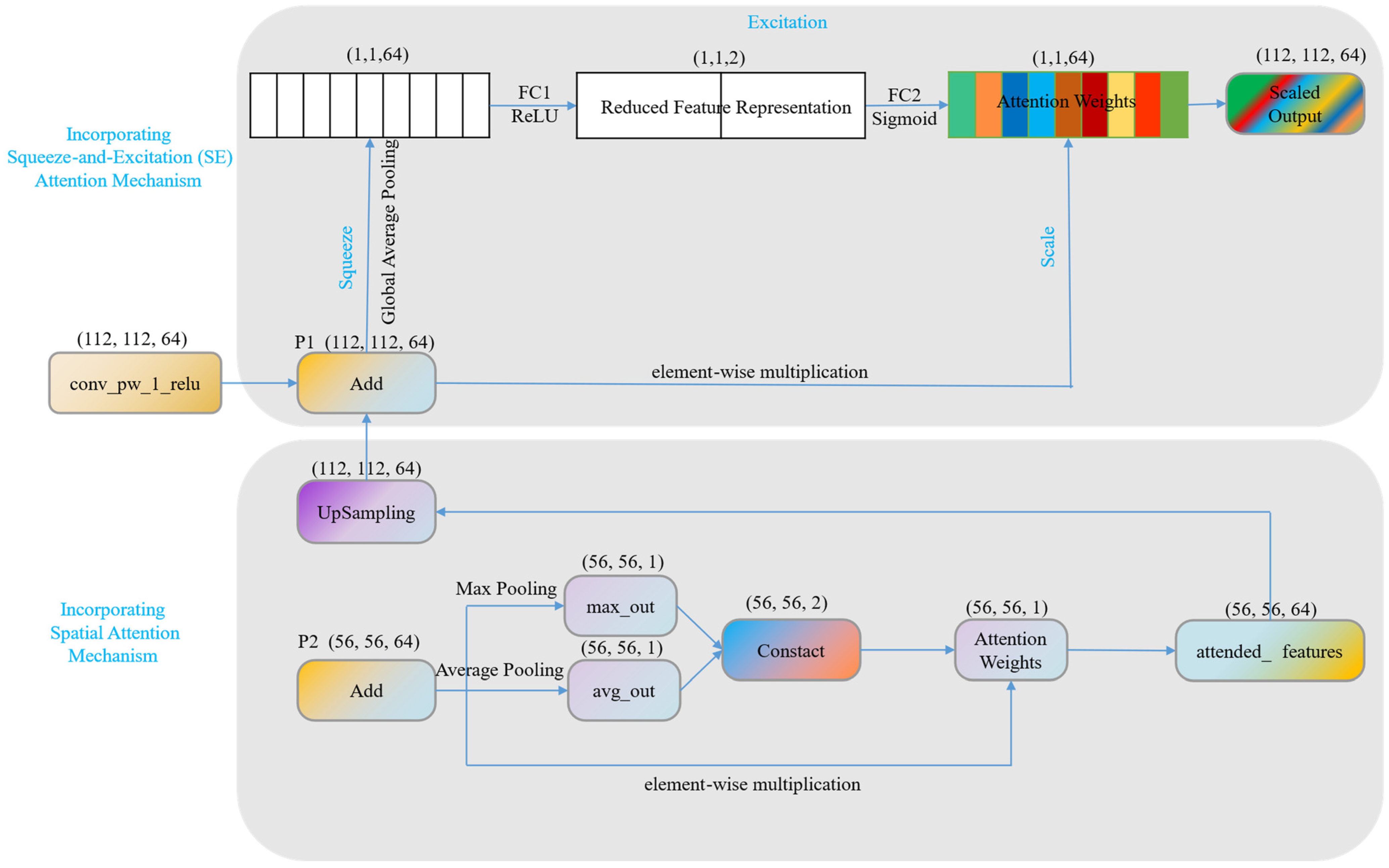

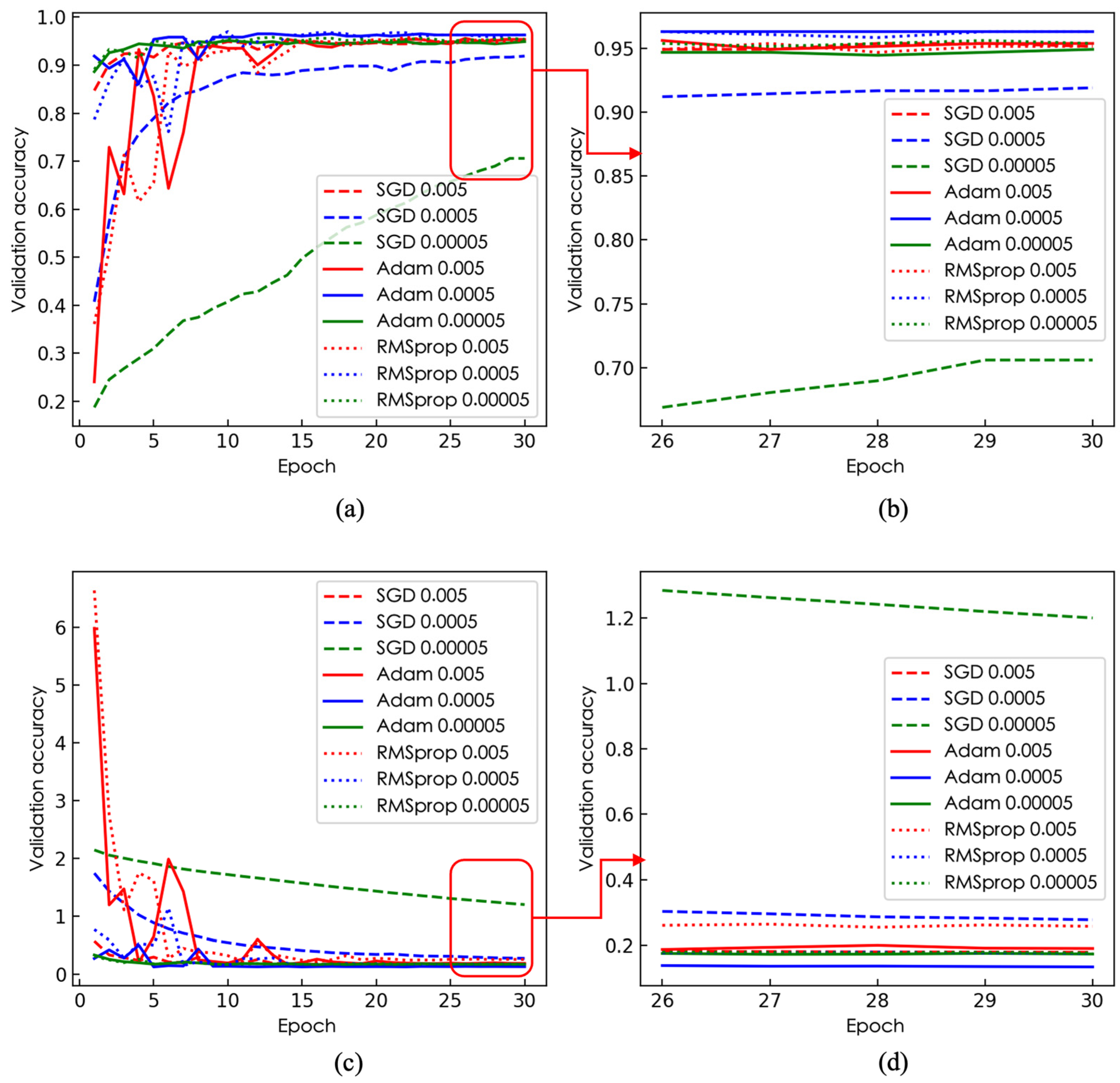

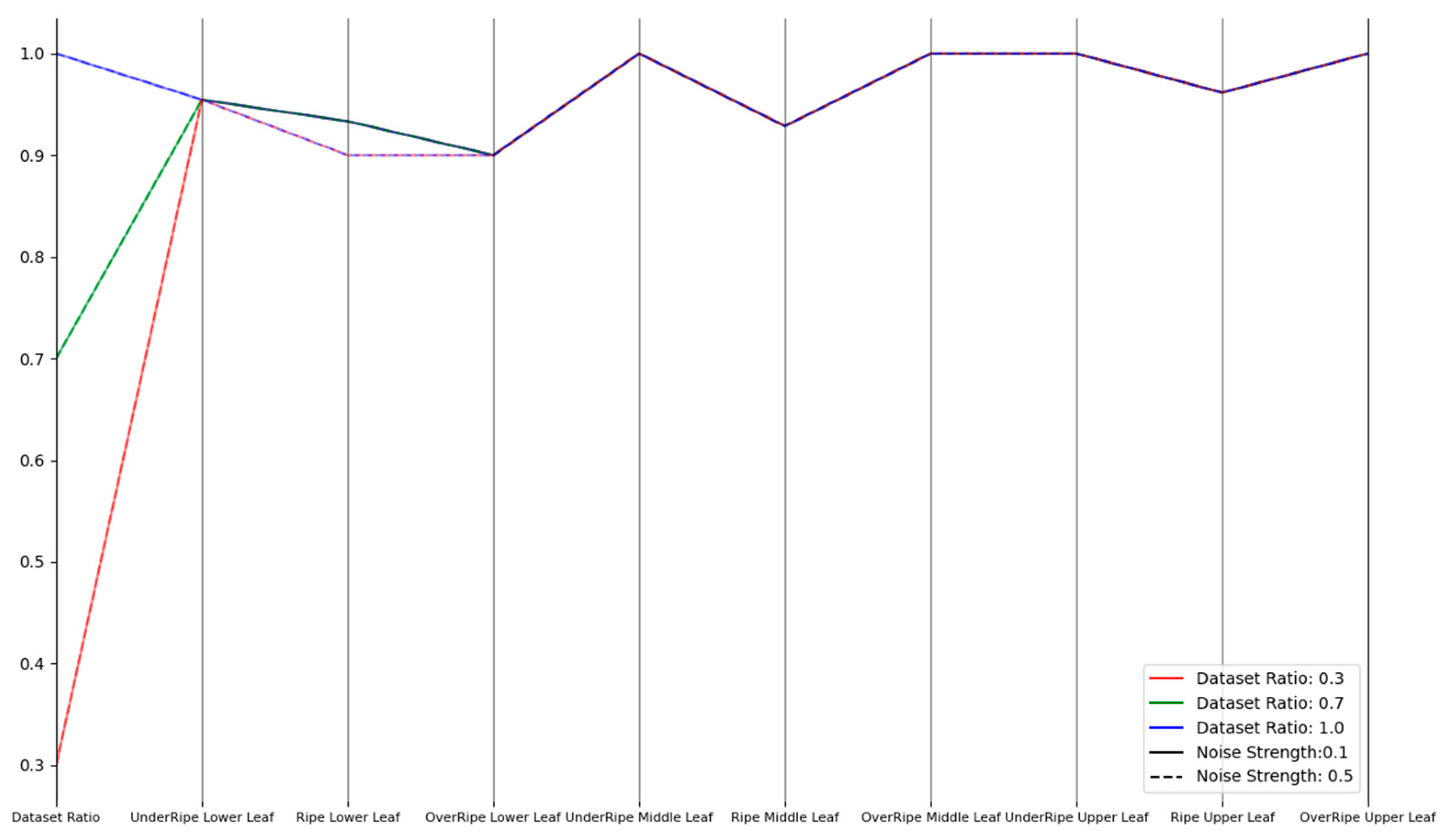

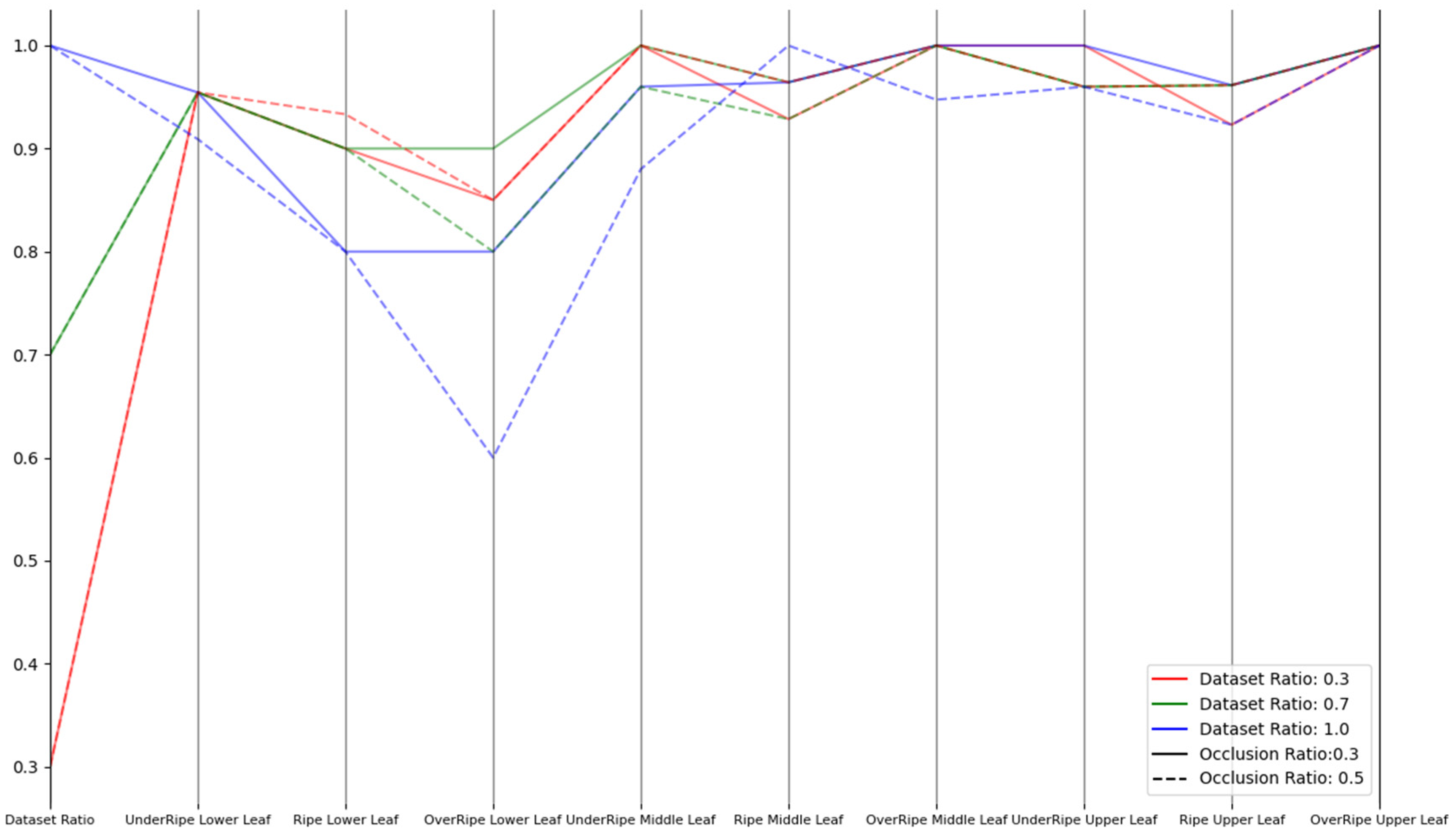
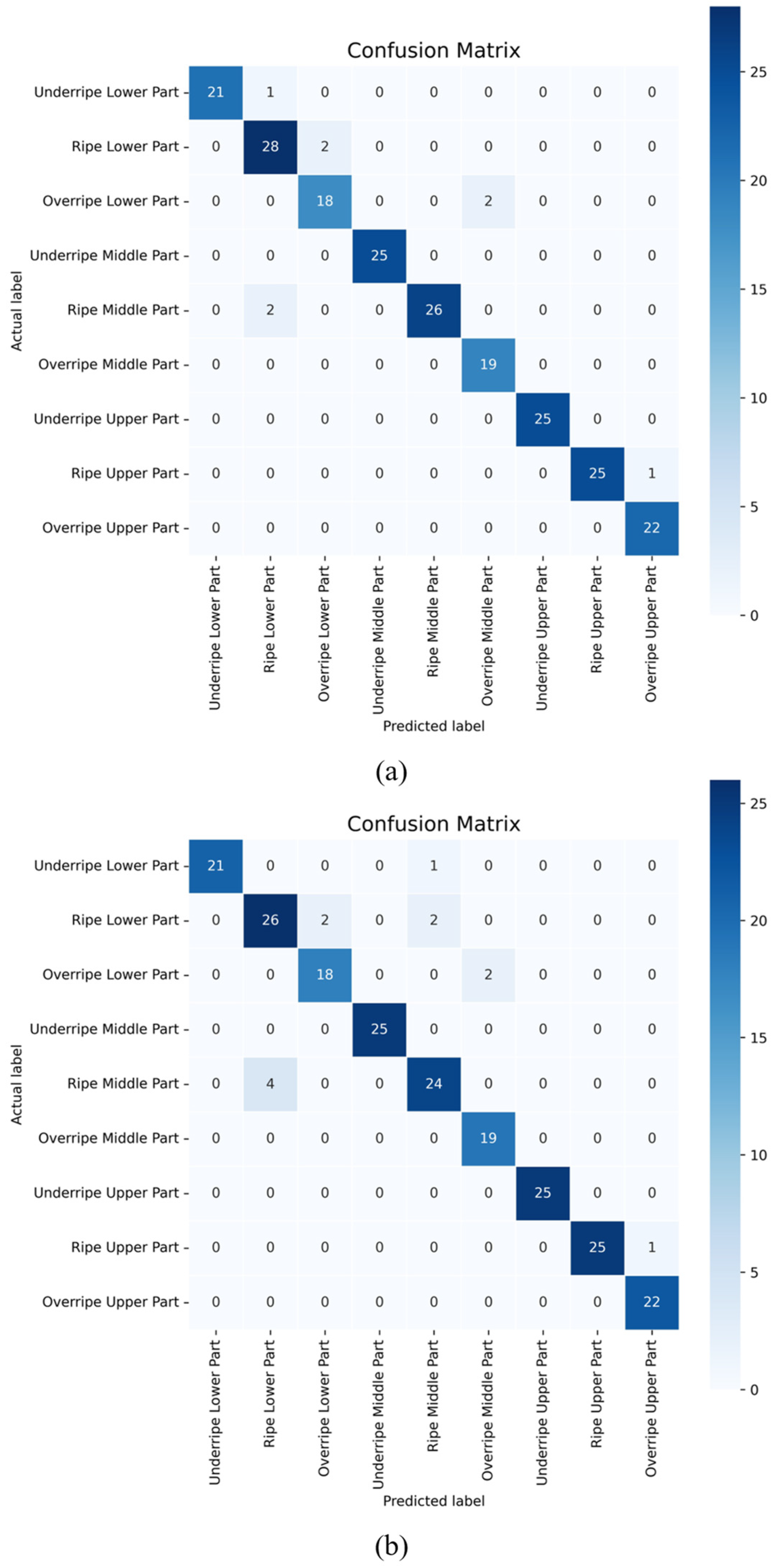
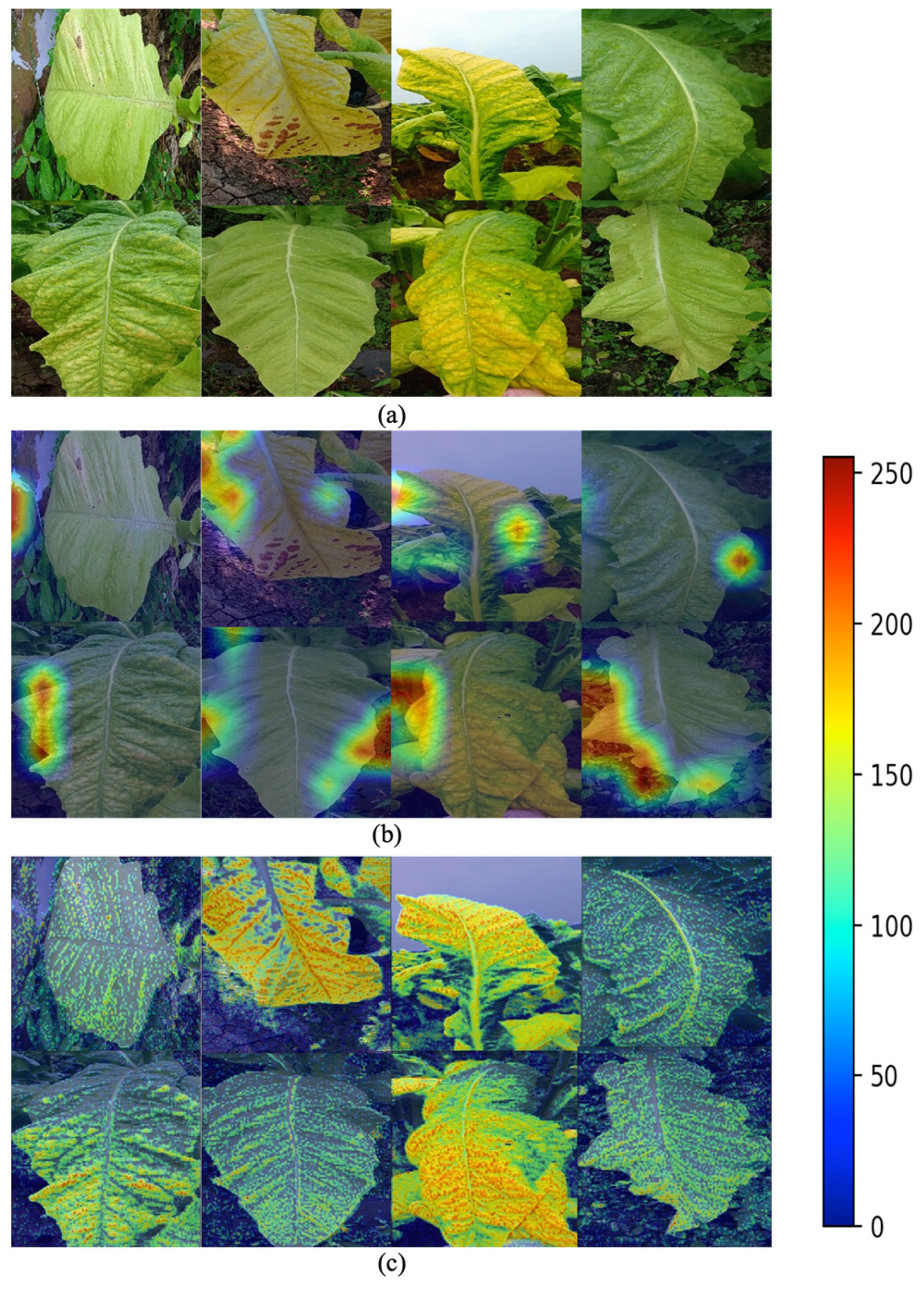
| Model | Validation Set Accuracy/% | Test Set Accuracy/% |
|---|---|---|
| MobileNetV1 | 95.37 | 94.47 |
| MobileNetV1 + FPN | 96.06 | 95.39 |
| MobileNetV1 + FPN + SE | 95.14 | 94.93 |
| MobileNetV1 + FPN + SP | 96.3 | 94.01 |
| MobileNetV1 + FPN + SP + SE | 96.3 | 96.31 |
| Model | Test Set Recognition Accuracy | Precision | Recall | F1 | Number of Parameters | Model Weight Size (M) | FPS | mPA |
|---|---|---|---|---|---|---|---|---|
| VGG16 | 0.7972 | 0.8058 | 0.7972 | 0.7986 | 134,297,417 | 537.2 | 48.14 | 79.72 |
| VGG19 | 0.7788 | 0.7849 | 0.7788 | 0.7781 | 139,607,113 | 558.5 | 39.82 | 77.88 |
| ResNet50 | 0.9217 | 0.9206 | 0.9217 | 0.9203 | 23,606,153 | 94.9 | 77.19 | 92.17 |
| EfficientNetB0 | 0.9355 | 0.937 | 0.9355 | 0.9359 | 4,061,100 | 16.8 | 74.58 | 59.91 |
| EfficientNetB1 | 0.9585 | 0.9595 | 0.9585 | 0.9579 | 6,586,768 | 27.1 | 59.37 | 59.91 |
| MobileNetV1 | 0.9447 | 0.9453 | 0.9447 | 0.9446 | 3,238,089 | 13.2 | 196.41 | 94.47 |
| MobileNetV2 | 0.9401 | 0.9451 | 0.9402 | 0.9422 | 2,269,513 | 9.5 | 133.63 | 94.01 |
| MobileNetV3Small | 0.9493 | 0.9513 | 0.9542 | 0.9525 | 1,539,193 | 6.7 | 145.66 | 94.93 |
| MobileNetV3Large | 0.9631 | 0.9631 | 0.9629 | 0.9646 | 4,237,961 | 17.7 | 107.18 | 96.31 |
| Improved MobileNetV1 | 0.9631 | 0.9647 | 0.9631 | 0.9633 | 3,357,276 | 13.7 | 128.12 | 96.31 |
Disclaimer/Publisher’s Note: The statements, opinions and data contained in all publications are solely those of the individual author(s) and contributor(s) and not of MDPI and/or the editor(s). MDPI and/or the editor(s) disclaim responsibility for any injury to people or property resulting from any ideas, methods, instructions or products referred to in the content. |
© 2023 by the authors. Licensee MDPI, Basel, Switzerland. This article is an open access article distributed under the terms and conditions of the Creative Commons Attribution (CC BY) license (https://creativecommons.org/licenses/by/4.0/).
Share and Cite
Zhang, Y.; Zhu, Y.; Liu, X.; Lu, Y.; Liu, C.; Zhou, X.; Fan, W. In-Field Tobacco Leaf Maturity Detection with an Enhanced MobileNetV1: Incorporating a Feature Pyramid Network and Attention Mechanism. Sensors 2023, 23, 5964. https://doi.org/10.3390/s23135964
Zhang Y, Zhu Y, Liu X, Lu Y, Liu C, Zhou X, Fan W. In-Field Tobacco Leaf Maturity Detection with an Enhanced MobileNetV1: Incorporating a Feature Pyramid Network and Attention Mechanism. Sensors. 2023; 23(13):5964. https://doi.org/10.3390/s23135964
Chicago/Turabian StyleZhang, Yi, Yushuang Zhu, Xiongwei Liu, Yingjian Lu, Chan Liu, Xixin Zhou, and Wei Fan. 2023. "In-Field Tobacco Leaf Maturity Detection with an Enhanced MobileNetV1: Incorporating a Feature Pyramid Network and Attention Mechanism" Sensors 23, no. 13: 5964. https://doi.org/10.3390/s23135964
APA StyleZhang, Y., Zhu, Y., Liu, X., Lu, Y., Liu, C., Zhou, X., & Fan, W. (2023). In-Field Tobacco Leaf Maturity Detection with an Enhanced MobileNetV1: Incorporating a Feature Pyramid Network and Attention Mechanism. Sensors, 23(13), 5964. https://doi.org/10.3390/s23135964





